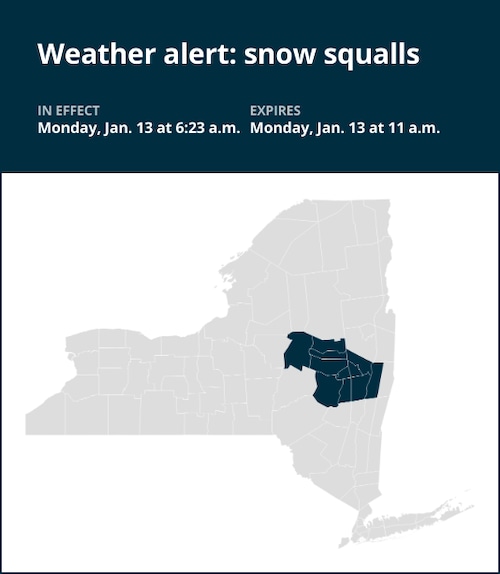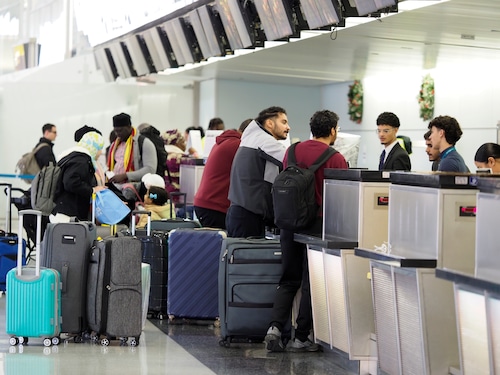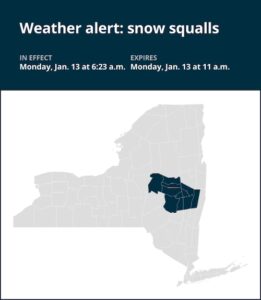At 6:23 a.m. on Monday, the National Weather Service issued a forecast for snow squalls in Herkimer, Fulton, Montgomery, Schoharie, Schenectady, Saratoga, Albany, and Rensselaer counties through 11 a.m.
Beginning early this afternoon in the western Mohawk Valley, scattered snow showers and a few snow squalls are predicted to move eastward into the Capital District by late afternoon. There is a chance of snow squalls during today’s PM commute. Road conditions and weather will change quickly in any impacted location, with short snowfall and wind gusts causing visibility to be restricted. During any snow squall, temperatures can surge into the mid-30s before quickly falling below freezing, creating a flash freeze that could make travel dangerous, according to the weather service.
“Be ready for drastically decreased visibility,” the weather agency says. The most intense downpours may result in brief whiteouts and very hazardous driving conditions. There is also a chance of icy roadways. Reduce your speed and make sure your headlights are on if you are traveling and come across unfavorable winter driving conditions.
Snow squalls: Safety protocols and prevention tips
What are snow squalls?
Strong cold fronts are frequently associated with snow squalls, which are short but intense winter weather phenomena. Even in the absence of a significant winter storm, they can quickly result in icy roads and unexpected whiteout conditions. Even while they often last less than an hour and may only cause slight snow accumulation, their reduced visibility, strong winds, and quickly dropping temperatures make them extremely dangerous for driving. In the past, these circumstances have resulted in fatal traffic accidents.
Understanding snow squalls vs. Snowstorms
The length of the event distinguishes a snowstorm from a snow squall. Typically lasting between 30 and 60 minutes, snow squalls are incredibly powerful. Days or even hours may pass during a snowfall.
Snow squall warnings
Similar to tornado and severe thunderstorm warnings, snow squall alerts are short-fused and targeted at specific locations. These alerts offer vital, extremely targeted information that can save lives. If your neighborhood is under a snow squall warning, stay indoors or postpone driving until the squall has passed.
Actions to take
When a snow squall warning is issued, people should heed the weather service’s instructions, which include the following crucial steps:
Avoid or postpone travel: It is best to wait until the snow squall has gone through your area before driving if a snow squall warning has been issued for your area. During snow squalls, roadways and highways are especially dangerous.
Decrease speed and improve visibility: If you are already traveling and won’t be able to get off the road in time, slow down and activate your headlights and hazard lights.
Keep a safe distance by giving the automobile in front of you plenty of space.
Steer clear of quick braking: Sudden braking can cause a vehicle to lose control in icy and slippery conditions. To reduce the chance of sliding or producing a chain reaction crash, it is safer to reduce your speed gradually.
Winter weather safety advice: Go to the weather service’s Winter Weather Safety page for advice on how to be safe before, during, and after a winter storm.
Prepare your car: Take proactive steps to get your car ready for winter driving conditions before you leave. This entails making sure your car’s fluids are topped off and inspecting your tires, brakes, and lights. The difficulties of winter driving are better handled by a well-maintained car.
Essentials for your car’s emergency kit: Always keep a first-aid kit, blankets, non-perishable food, water, a flashlight, and other essentials in your car’s emergency kit. For better tire traction, add jumper cables, flares or a reflective triangle, ice scraper, a map, a car cell phone charger, and cat litter or sand. Should you experience an emergency or unplanned breakdown while traveling, these supplies can be quite helpful.
In conclusion, putting one’s own safety first and following the weather service’s advice can greatly reduce dangers when a snow squall warning is in effect. People can travel through these winter dangers with more assurance and security if they are aware of them, plan beforehand, and remain alert.
United Robots offers a service called Advance Local Weather Alerts that gathers the most recent information from the National Weather Service using machine learning.







+ There are no comments
Add yours